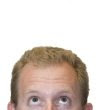1-15-06 A few laboratory pictures
We've been playing with scallop abductin tissue in lab. This is
the rubbery bit of tissue in the hinge of a scallop's shells that
forces the two shell valve apart. We have been looking for effects
of temperature on the abductin rubber to inform us about its
material properties. Mark came up with a pair of interesting
experimental setups to run these tests, and with the exception of
clay, a bit of mirror, a laser pointer, and some z-spar, we were
able to piece everything else together using equipment from around
the lab and stockroom.
Here's a wide shot of one setup used to measure the resilience of the abductin. The basic idea is to take the scallop shell sitting in the water bath on the floor and twang the upper shell with your finger. This makes it oscillate up and down, and you can watch the deterioration ofthe oscillations over time to get an idea of how springy the material is.

Inside the water bath is the scallop. Most of the upper shell has been cut away, and a piece of plastic syringe is glued in its place. On top of the syringe is a bit of mirror, for reflecting the laser beam.

The tricky bit of the setup is how we record the oscillations of the shell. The mirror and laser pointer project a spot of light up onto the ceiling. If you twang the shell, the point of light bounces back andforth across the ceiling. The trick then is to turn that laser line into a sine wave trace so that we can make measurements of the amplitude of the wave as it decays. That's where we got lucky and found a bacterial culture wheel in the stockroom. We stripped off the wheel portion andused the slow-turning motor drive. We attached my camera body to the motor drive, and pointed it at the ceiling. When you turn the motor on,the camera pans through an arc. With a 2.5 second exposure, you can capture several oscillations of the laser beam.

The output from the camera is a really nice sine wave drawn across the sensor of the camera as it is rotating.

Our other setup is another complicated conglomeration of a water bath, some pipettes, clay, a linearly variable differential transformer, precision weights, some suture string, and a chart recorder. (Don't tell Mike Boller that we used the chart recorder instead of the A-D board that he set up)

Here's a wide shot of one setup used to measure the resilience of the abductin. The basic idea is to take the scallop shell sitting in the water bath on the floor and twang the upper shell with your finger. This makes it oscillate up and down, and you can watch the deterioration ofthe oscillations over time to get an idea of how springy the material is.

Inside the water bath is the scallop. Most of the upper shell has been cut away, and a piece of plastic syringe is glued in its place. On top of the syringe is a bit of mirror, for reflecting the laser beam.

The tricky bit of the setup is how we record the oscillations of the shell. The mirror and laser pointer project a spot of light up onto the ceiling. If you twang the shell, the point of light bounces back andforth across the ceiling. The trick then is to turn that laser line into a sine wave trace so that we can make measurements of the amplitude of the wave as it decays. That's where we got lucky and found a bacterial culture wheel in the stockroom. We stripped off the wheel portion andused the slow-turning motor drive. We attached my camera body to the motor drive, and pointed it at the ceiling. When you turn the motor on,the camera pans through an arc. With a 2.5 second exposure, you can capture several oscillations of the laser beam.

The output from the camera is a really nice sine wave drawn across the sensor of the camera as it is rotating.

Our other setup is another complicated conglomeration of a water bath, some pipettes, clay, a linearly variable differential transformer, precision weights, some suture string, and a chart recorder. (Don't tell Mike Boller that we used the chart recorder instead of the A-D board that he set up)


<< Home